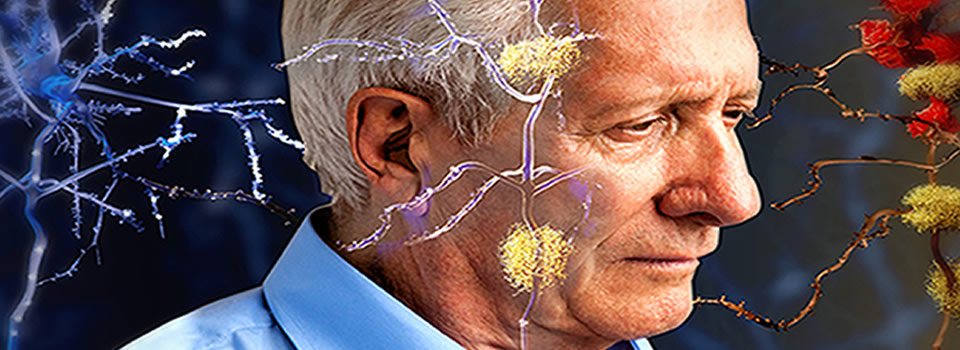Alzheimer-patiënten kunnen mogelijk nog nieuwe herinneringen aanmaken
 Uit nieuw Amerikaans onderzoek blijkt dat Alzheimer-patiënten nog wel nieuwe herinneringen kunnen vormen, maar niet meer kunnen ophalen. Dit biedt hoop!
Uit nieuw Amerikaans onderzoek blijkt dat Alzheimer-patiënten nog wel nieuwe herinneringen kunnen vormen, maar niet meer kunnen ophalen. Dit biedt hoop!
Onderzoekers hebben muizen met beginnende Alzheimer onderzocht. Dit zijn muizen met mutaties in de genen, waardoor zij te maken krijgen met plaque in hun hersenen, net zoals Alzheimer-patiënten. De wetenschappers slaagden er in om een bepaalde groep geheugencellen aan de onderkant van de hippocampus te activeren met elektriciteit, waardoor het geheugen weer goed werkte en herinneringen weer opgeroepen konden worden. Wat blijkt: de geheugencellen van de muizen waren te zwak geworden en dus niet in staat om informatie op te halen. Door deze cellen te activeren werden de muizen weer gezond.
Bart Rutten (hoofd neurowetenschappen aan de Universiteit van Maastricht) vertelt aan De Volkskrant dat muizen geen mensen zijn. “Wel is het vernieuwend onderzoek, omdat voor het eerst is aangetoond welke zenuwcellen in de hippocampus precies verantwoordelijk zijn voor problemen met het ophalen van herinneringen bij beginnende Alzheimer.”
De reden dat het niet bij mensen uitgevoerd kan worden, is omdat amyloïde plaques bij mensen op een andere manier ontwikkelen. Wetenschappers zijn hierdoor niet in staat om cellen met licht te activeren. Maar wat niet is, kan nog komen. Er worden al experimenten gedaan waarbij de hippocampus wordt gestimuleerd. Dit leidt tot het ontstaan van nieuwe neuronen en verbetert het geheugen van sommige Alzheimer-patiënten.
Overigens wordt er op dit moment veel onderzoek gedaan naar Alzheimer. In december maakten wetenschappers bekend dat een stofje uit energiedrank Alzheimer-plaques opruimt. Ook werd vorig jaar bekend dat het experimentele kankermedicijn AZD05030 de opeenstapeling van het eiwitfragment bèta-amyloïde – een kenmerk van Alzheimer – kan tegengaan.
Ook interessant:
Newly published research led by the Yale School of Public Health demonstrates that individuals who hold negative beliefs about aging are more likely to have brain changes associated with Alzheimer’s disease.
The study suggests that combatting negative beliefs about aging, such as elderly people are decrepit, could potentially offer a way to reduce the rapidly rising rate of Alzheimer’s disease, a devastating neurodegenerative disorder that causes dementia in more than 5 million Americans.
The study led by Becca Levy, associate professor of public health and of psychology, is the first to link the brain changes related to Alzheimer’s disease to a cultural-based psychosocial risk factor. The findings were published online Dec. 7 in the journal Psychology and Aging.
“We believe it is the stress generated by the negative beliefs about aging that individuals sometimes internalize from society that can result in pathological brain changes,” said Levy. “Although the findings are concerning, it is encouraging to realize that these negative beliefs about aging can be mitigated and positive beliefs about aging can be reinforced, so that the adverse impact is not inevitable.”
Study authors examined healthy, dementia-free subjects from the Baltimore Longitudinal Study of Aging, the nation’s longest-running scientific study of aging. Based on MRIs, the researchers found that participants who held more negative beliefs about aging showed a greater decline in the volume of the hippocampus, a part of the brain crucial to memory. Reduced hippocampus volume is an indicator of Alzheimer’s disease.
Then researchers used brain autopsies to examine two other indicators of Alzheimer’s disease: amyloid plaques, which are protein clusters that build up between brain cells; and neurofibrillary tangles, which are twisted strands of protein that build up within brain cells. Participants holding more negative beliefs about aging had a significantly greater number of plaques and tangles. The age stereotypes were measured an average of 28 years before the plaques and tangles.
In both stages of the study, Levy and her colleagues adjusted for other known risk factors for Alzheimer’s disease, including health and age.
Other authors include biostatistician Martin Slade of the Yale School of Medicine, neurologist Juan Troncoso of the Johns Hopkins School of Medicine, and a team of researchers from the Intramural Research Program of the National Institute on Aging (NIA), which included its scientific director Luigi Ferrucci, cognitive psychologist Alan Zonderman, and neuroscientist Susan Resnick. The study was made possible by grants from the NIA.
Bron: http://news.yale.edu/